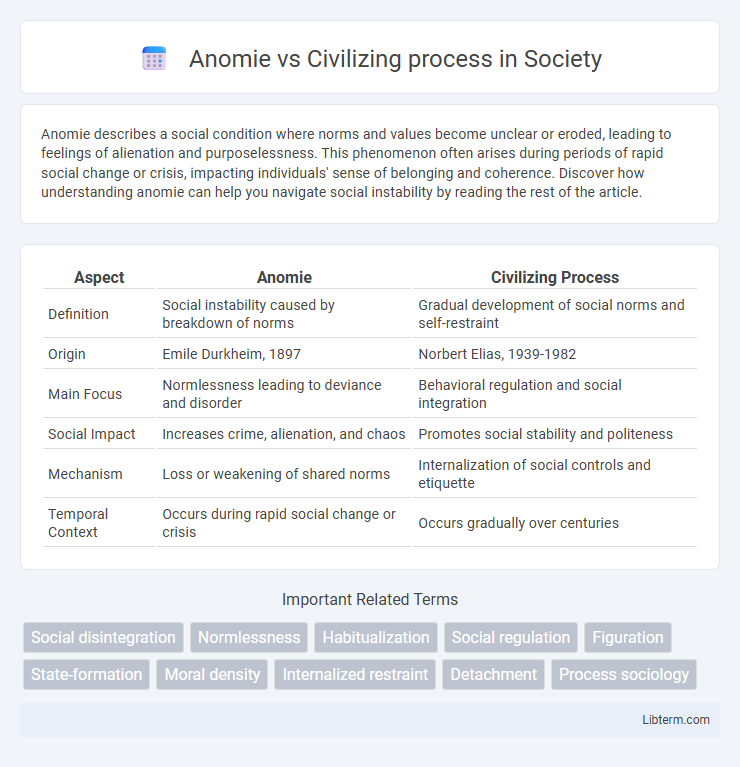Anomie describes a social condition where norms and values become unclear or eroded, leading to feelings of alienation and purposelessness. This phenomenon often arises during periods of rapid social change or crisis, impacting individuals' sense of belonging and coherence. Discover how understanding anomie can help you navigate social instability by reading the rest of the article.
Table of Comparison
| Aspect | Anomie | Civilizing Process |
|---|---|---|
| Definition | Social instability caused by breakdown of norms | Gradual development of social norms and self-restraint |
| Origin | Emile Durkheim, 1897 | Norbert Elias, 1939-1982 |
| Main Focus | Normlessness leading to deviance and disorder | Behavioral regulation and social integration |
| Social Impact | Increases crime, alienation, and chaos | Promotes social stability and politeness |
| Mechanism | Loss or weakening of shared norms | Internalization of social controls and etiquette |
| Temporal Context | Occurs during rapid social change or crisis | Occurs gradually over centuries |
Understanding Anomie: A Conceptual Overview
Anomie describes a state of normlessness where societal norms break down, leading to social instability and individual disorientation. Emile Durkheim originally conceptualized anomie as a condition arising from rapid social change or lack of regulation, causing individuals to feel disconnected. In contrast, the civilizing process, theorized by Norbert Elias, emphasizes the gradual internalization of social norms and self-regulation that fosters social cohesion and reduces violent behavior.
The Civilizing Process: Historical Perspectives
The Civilizing Process, analyzed by Norbert Elias, traces the gradual development of social norms, self-restraint, and centralized state control from medieval Europe to modern times. It highlights the transformation of behaviors, manners, and emotions through long-term social integration and differentiation that reduced violence and fostered complex social structures. This historical perspective contrasts with anomie, which reflects social disintegration and normlessness, emphasizing stability and gradual cultural evolution in Elias's framework.
Origins and Development of Anomie Theory
Anomie theory originated from Emile Durkheim's analysis of social instability arising from normlessness during rapid societal change, as elaborated in his seminal work *The Division of Labour in Society* (1893) and *Suicide* (1897). The development of anomie theory centers on how disruptions in social regulation and cohesion lead to feelings of alienation and deviant behavior. Unlike Norbert Elias's civilizing process, which traces long-term social self-regulation and increasing restraint, anomie theory focuses on the breakdown of normative structures during periods of social upheaval and modernization.
Key Features of the Civilizing Process
The civilizing process is characterized by the gradual refinement of social behaviors, increased self-restraint, and the internalization of norms promoting order and predictability within societies. This process involves the development of complex institutions, such as legal systems and educational structures, that regulate conduct and reduce violent conflicts. Key features include the monopolization of legitimate violence by the state, heightened social interdependence, and the transformation of emotional expressions towards greater control and subtlety.
Comparing Anomie and the Civilizing Process
Anomie, as defined by Emile Durkheim, refers to a state of social instability caused by the breakdown of norms, leading to feelings of normlessness and social disintegration. In contrast, Norbert Elias's Civilizing Process describes the long-term social development marked by increased self-restraint, refined social manners, and the establishment of complex social norms that regulate behavior. While anomie emphasizes the consequences of norm erosion in modern societies, the Civilizing Process highlights the progressive internalization of social controls fostering cohesion and stability.
Social Order and Regulation: Contrasting Approaches
Anomie, characterized by a breakdown of social norms and resulting in social disorder, contrasts sharply with the civilizing process, which emphasizes the gradual development of self-regulation and social control mechanisms. Durkheim's concept of anomie highlights the dangers of normlessness in destabilizing social order, while Elias's civilizing process describes the historical evolution of etiquette and internal restraint as foundations for societal regulation. Together, these theories illustrate divergent pathways to understanding how societies maintain cohesion and manage individual behavior within complex social structures.
Psychological Impacts: Anomie vs. Social Restraint
Anomie manifests psychologically as feelings of alienation, normlessness, and purposelessness due to weakened social norms, often leading to increased anxiety and depressive symptoms. In contrast, the civilizing process fosters social restraint by internalizing societal norms and self-control, promoting psychological stability and a sense of belonging. The tension between these states highlights how fluctuating levels of social regulation critically influence individual mental health and social cohesion.
Cultural Change and Social Cohesion
Anomie, characterized by a breakdown of social norms, disrupts cultural change by fostering individual disorientation and weakening social cohesion. The Civilizing Process promotes gradual cultural transformation through internalized self-restraint and institutional regulation, enhancing social bonds and collective order. Together, these concepts illustrate how social stability and cultural evolution depend on the balance between normative regulation and individual adaptation.
Modern Implications: From Anomie to Civilization
Anomie, characterized by social instability and normlessness, contrasts sharply with the civilizing process, which fosters social order and behavioral regulation through the internalization of norms. Modern implications reveal a tension where rapid societal changes and technological advancements contribute to anomie by disrupting established social frameworks, while simultaneously, globalization and institutional development promote the civilizing process by enhancing cooperation and formalized social controls. Understanding this dynamic interplay is crucial for addressing contemporary challenges such as social fragmentation, mental health crises, and the evolution of governance systems in increasingly complex societies.
Conclusion: Integrating Theories for Social Analysis
Anomie and the civilizing process theories collectively enhance social analysis by addressing the breakdown of social norms and the evolution of societal self-regulation mechanisms. Anomie highlights normlessness and social instability, while the civilizing process emphasizes long-term behavioral constraints fostering social order. Integrating these perspectives provides a comprehensive framework to understand both social disintegration and the development of structures promoting stability and control.
Anomie Infographic

 libterm.com
libterm.com